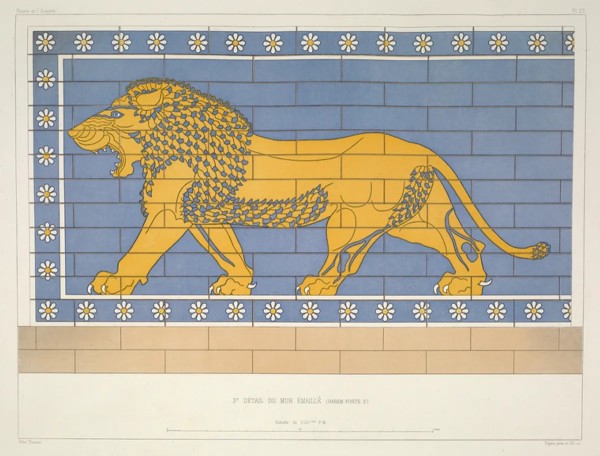
A drawing of the lion symbol as recreated by French excavators in the late 19th century. Image Credit: The New York Public Library.
Ishtartv.com - iflscience.com
DR.
RUSSELL MOUL
Certain
symbols appear on temple walls at various locations in the ancient city of
Dūr-Šarrukīn, where Khorsabad, Iraq, is today. At the time of their creation,
the city was ruled by Sargon II, who ruled over the Assyrian kingdom from 721
to 705 BCE. The king was already middle-aged by the time he took the throne (by
force) from his brother, Shalmaneser V.
He
was remembered as a great king who founded the Sargonid Dynasty, which ruled
the Neo-Assyrian Empire for another century before it fell. He was particularly
fond of building monuments as well as being a patron of the arts.
The
region, which encompasses modern Iraq, parts of Iran, Turkey, and Syria is
often regarded as the “cradle of civilization” today. It is the place where
empires were first born, along with cities and even written language. It was an
incredibly important area for much of human history, and so interpreting the
symbols may help us understand more about the ancient humans that lived there.
The
symbols tend to appear in the same sequence consisting of a lion, eagle, bull,
fig tree and a plough. They were first recorded and transmitted to public
audiences by French excavators who visited the location at the end of the 19th
century.
Since
their rediscovery, many researchers have attempted to interpret their meaning.
Some believe they are like Egyptian hieroglyphs, some sort of expression of
imperial power, or may even spell out the king’s name.
But
now an Assyriologist from Trinity College Dublin has proposed a new
explanation: the symbols may spell out Sargon’s name (šargīnu), while also
representing specific constellations.
“The study of
ancient languages and cultures is full of puzzles of all shapes and sizes, but
it’s not often in the Ancient Near East that one faces mystery symbols on a
temple wall,” Dr Martin Worthington explained in a statement.
According
to Worthington, the symbols can also be understood as a constellation. For
instance, the lion represents “Leo”, and the eagle “Aquilla”. Many of our
existing constellations were inherited from the Greeks who themselves inherited
those from Mesopotamia, so we would recognize them today. However, we have
dropped others, including the “jaw”, which Worthington believes was represented
by the symbol of the fig tree. This, he argues, comes from the belief that the
word for “tree” – iṣu – sounds similar to that for jaw – isu.
“The effect of
the five symbols, was to place Sargon’s name in the heavens, for all eternity –
a clever way to make the king’s name immortal”, Worthington added. “And, of
course, the idea of bombastic individuals writing their name on buildings is
not unique to ancient Assyria…”.
Yet
Worthington is aware that his idea is not set in stone, as it were. “I can’t
prove my theory, but the fact it works for both the five-symbol sequence and
the three-symbol sequence, and that the symbols can also be understood as
culturally appropriate constellations, strikes me as highly suggestive. The
odd[s] against it all being happenstance are – forgive the pun – astronomical”.
*The
study is published in the Bulletin of the American Society of Overseas
Research.

Drawings of the eagle and bull symbols recorded by French excavators at the end of the 19th century. Image credit: The New York Public Library.

A drawing of the fig tree and the plough as recorded by French excavators at the end of the 19th century. Image credit: The New York Public Library.
|